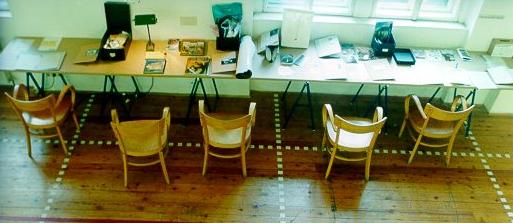|
RENE RUSJAN Verwandelt Galerien in Alltagsorte - es geht
ihr um eine Demystifizierung des White Cube. In ihrem Projekt in der KUNSTHALLE
EXNERGASSE wird die Galerie zu einem angenehmen Kommunikationsplatz,
die einem privaten Wohnort gleich kommt. Sie versucht mit dem Galerienbesucher
schriftlich über seine Wahrnehmung der Stadt Wien zu kommunizieren. (more
on the exhibition: ttp://kunsthalle.wuk.at/archiv/1999/SiQ99/02index.htm
and text of Vanesa Cvahte, the curator: here)
|
 |
|
"Visiting Vienna" by Rene Rusjan I come from Ljubljana, Slovenia, and I'm a guest in your town. Wien, or Vienna; we call it Dunaj, Croats and Serbs call it Bec. Since I was a little girl I've known about your town, but I don't really have any personal experiences with it. It's partly the picture my grandmother used to tell me - it was her capital city in her youth - and partly a picture I got in my school years. Every second very important person from Slovenian history used to live at least a part of his life in Dunaj. And as they were usually poor, Slovenes have a saying: "Ce gre na Dunaj, pusti trebuh zunaj." It means, When you visit Vienna, leave your belly behind. But it doesn't rhyme in English. And, of course, I've picked up other pieces of my mental picture of Dunaj from all around. Now, I'm curious. I assume that not all of you like the Vienna snitzel und apfelstrudel, you don't eat too sweet cakes so very often (even though you meet in cafes?), nor you go to Prater every Sunday. I'm sure that many of you can't stand Hundertwasser and that Vienna waltzer isn't 'your' music. What a bunch of stereotypes! However, it's not only me, but also most of the people I know would share these with me. Of course, these people don't know Vienna from the close. Yes, I certainly know that you live in the present. But tell me about it. Correct my picture. And I will try to add to your picture of "the other side of the Alps". Ljubljana, Slovenia, former Yugoslavia. I know, unfortunately, you have got plenty of information on the first pages of world's newspapers during the last decade. But a closer look? I'm sure your bag is full of stereotypes as well. Let's get to know each other. Give me a good guidance through your town. I'll bring some materials with me, as well. It can be a good start of a relationship. Greetings from Ljubljana.
VISITING VIENNA READING ROOM I work with places. Different ones. Galleries are only one kind of them. Actually I don't really like galleries very much. At least not as my only possibility of working with a place. They don't have much to say. I also work with people. And their stories. And stories of people in places. I like to search for memories of a place. And again, people outside galleries have much more to tell me. But on the other hand, galleries are places as well. With their stories, with people who can usually tell stories about art, who actually show art in galleries. And there are other people - visitors who come to see the Art. I don't make the Art. In non-gallery places (abandoned places, houses, parks, streets) I work with the place, I try to get close to it, to get to know its story. I do work in a field of art but far from the Art.A gallery is something else in one way. It is a place to show the Art. I don't practice it, but I see a gallery as a place where I can give statements about art and the Art and other matters that occupy me and my time. In Vienna I am taking the opportunity to get closer to the city, to contact the people of Vienna. I am using the gallery as a place of this contact. I am a visitor. I am a guest in the town, and I temporarily use this little place in the gallery to meet my guides. And I want my temporary guests to feel good in my corners. To relax in the gallery, to take a rest, to drink some tea, to read a newspaper, to converse with me, to write me a letter. Something like meeting in a caffe and chat, even if I'm not there. |